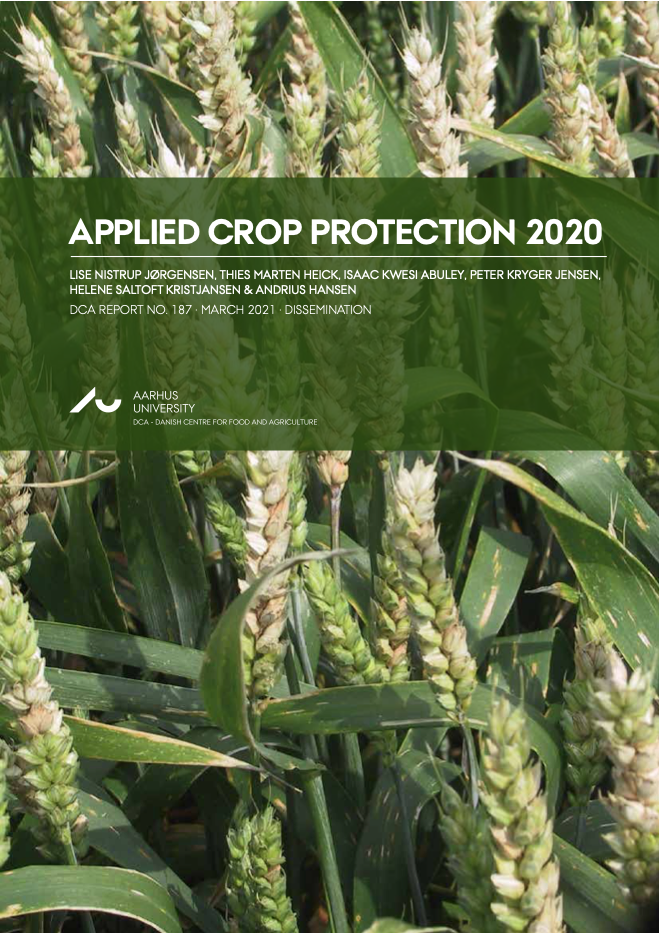New results from the experiments with applied crop protection
The annual report on Applied Crop Protection has just been published with the latest results from pesticide testing and other forms of crop protection.

In 2020, there was a strong focus on a global pandemic, but despite lockdowns and Covid-19 regulations, researchers from, among others, the Department of Agroecology succeeded in conducting experiments with plant protection. The results are described in the annual report on Applied Crop Protection.
In the new report, you will find answers to what diseases attacked the crops and how well different pesticides worked. You can read about septoria in wheat, and diseases of potatoes and sugar beets. Or what about the diseases that affected red fescue?
Weather, disease attacks, and pests
The 2020 edition of the report "Applied Crop Protection" has been published by DCA - National Centre for Food and Agriculture. It is an annual report with results that can be used for practical advice to farmers, advisors, industry, and researchers about the most current and optimal crop protection.
In this latest issue you can read about the weather and the trial season 2020, disease attacks, effects of new fungicides, including optimal dosing and timing, results of various control strategies, including testing of decision support systems for the control of specific pests, results regarding fungicide resistance, results from monitoring for diseases in red fescue, the ranking of the varieties' resistance to Fusarium and tan spot in wheat, possibilities for reduction of drift when spraying as well as testing of agents for less cultivated crops.
Specific effects in 2020
“Each growing season provides good opportunities to demonstrate specific effects from different control strategies. But just to name a few of the elements from this edition of the report, I would like to point out nine different points, ”says Lise Nistrup Jørgensen, who is a senior researcher at the Department of Agroecology.
The nine points pointed out bu Lise Nistrup Jørgensen are:
- Despite moderate disease attacks, there were still good opportunities to rank the effects of fungicides on e.g. septoria in wheat and ramularia in barley.
- Comparison of 10 years of experiments with susceptibility of wheat varieties to fusarium clearly showed that some varieties are better at suppressing toxin formation than others.
- Data from potatoes showed a clear benefit after using damage thresholds with good opportunities to reduce input.
- Experiments with artificial infection of cottony rot fungus in rapeseed showed large differences in the effect of the agents.
- Control of mildew in beets is challenged because of resistance - the results show what alternatives are available.
- The boom height must be correct when drift by spraying is to be minimised - but what effect does the boom height actually have on drift?
- Experiments in carrots have explored potential opportunities to control weeds in carrots - there seem to be good opportunities to supplement the current agents.
- Alternatives to glyphosate and diquat have been tested for pre-emergence treatment in vegetable production - the results with combinations of agents are interesting and the experimental work will continue in 2021.
- Alternative agents have been compared with insecticides to control the pieris butterfly's catarpillar and thrips in greenhouses. At certain stages, the results are promising.
Like previous reports, the 2020 report is based on results from experiments conducted at the Department of Agroecology regarding crop protection. The report summarises the data considered relevant to practical agriculture and counseling.
Most of the experiments have been carried out in the field, but there are also results from experiments in greenhouses and semifields.
Additional information | |
|---|---|
| We strive to ensure that all our articles live up to the Danish universities' principles for good research communication (scroll down to find the English version on the web-site). Because of this the article will be supplemented with the following information: | |
| Funding | The report is based on trials funded by many different sources. It is specifically stated for each chapter in the report, but covers i.e. input from the agrochemical companies, processing companies, the kartoffelafgiftsfonden, the sukkerroeafgiftsfonden, the frøafgiftsfonden, and direct funding from Aarhus University |
| Collaborators | Staff at Aarhus University (Department of Agroecology and DCA - National Center for Food and Agriculture) - Suppliers of pesticides and crop varieties have participated along with people from SEGES and local counseling centers, who have been used in connection with the experiments. None of the partners have been involved in the creation of the report. |
| Read more | You can read the report ”Applied Crop Protection”. It is written by Lise Nistrup Jørgensen, Thies Marten Heick, Isaac Kwesi Abuley, Peter Kryger Jensen, Helene Saltoft Kristiansen, and Andrius Hansen. It has been through internal review by Per Kudsk, Peter Kryger Jensen, Mette Sønderskov, Solvejg Mathiasen, and Niels Holst. |
| Contact | Senior researcher Lise Nistrup Jørgensen, Department of Agroecology, Aarhus University. Tel .: +45 2228 3352. E-mail: lisen.jorgensen@agro.au.dk |
